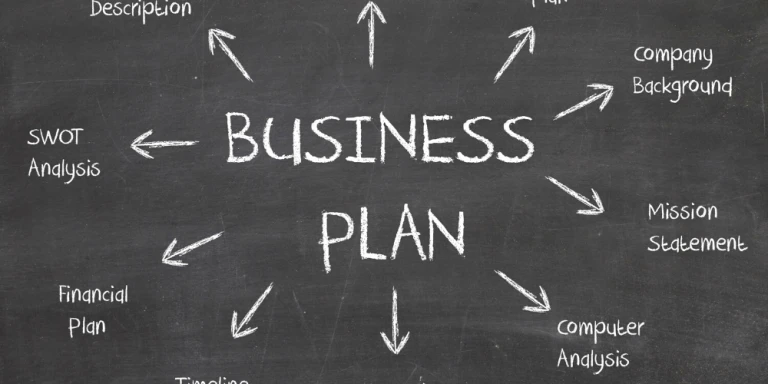How to write a business plan
HOME / How to write a business plan
When you start a business, there are a million things you need to do. Trust us, we’ve counted them.
So researching and writing a business plan can feel like a ‘maybe next week’ activity that never reaches the top of your to do list.
However, businesses who write a business plan are more likely to succeed.
So even though it’s tempting to focus on quicker wins, writing a business plan really should be one of your top priorities.

STEP 1 : Understand why you need a business plan
The first step to writing a business plan is to understand the basics. What is a business plan? Why write a business plan? What does a business plan include?
What is a business plan?
A business plan is a document that describes a new business. It includes important information about your business and its structure, what you plan to achieve, and how you plan to do it.
Written by an aspiring entrepreneur at the beginning of their business journey, it provides a roadmap of what they hope to achieve.
You don’t have to have a business degree or a multi-million-pound idea to write a business plan. Anyone starting a business should take the time to commit their vision to paper.
Wondering if you've got what it takes to start a business? Check out the 12 essential attributes of an entrepreneur.
We also have a full guide on How To Start Your Own Business.
Three reasons to write a business plan
(1) Focus your mind (2) Test your ideas (3) Attract funding. It might take a lot of thinking about... but it's a total no-brainer that you need one.
Why write a business plan?
A business plan sets out your vision and strategy for your business. It helps you and other people to understand what you hope to achieve. It is essential if you want to secure funding for your business, as lenders will want to understand your plans for your business. Here are the main reasons for writing a business plan.
A business plan helps focus your mind: If you want to succeed, you need to take your new business seriously. Having a business plan is your first step to manifesting your dreams as reality. It turns a cloud of great ideas into a firm plan about how you’ll achieve them. It can actually be a relief to get things out of your head and onto paper. And it provides a structure for your first year in business, giving you clear steps to take towards your future success.
A business plan makes you more realistic: Self-confidence is brilliant but it doesn’t pay the bills. You’ll need more than blind faith to create a firm financial foundation for your new venture. A business plan helps you understand what you can afford to do and how much you can realistically expect to make. By helping you prioritise limited resources, it makes you far more likely to succeed.
A business plan helps secure funding: Whether you’re planning to find an investor or take out a business loan, you’ll need a plan to demonstrate that your business is financially viable. Lenders and investors will want to see that you’ve thought through the full implications of your business and are ready to take your financial responsibilities seriously. Check out our Guide to Funding a New Business.
What does a business plan include?
Don’t worry. There’s no set formula for writing a business plan. We recommend you follow a business plan template because it can make it easier to write your plan. But your business won’t suffer if you don’t follow a certain template.
However, there are key elements that they always include:
details about your business / business idea
your target market and how you'll reach them
your goals and how you plan to achieve them
details about your finances
How long should a business plan be?
That depends on who’s going to read it. There are two main audiences for a business plan: you and potential funders.
Just you - to help plan your journey and set objectives - 10-12 pages
For funders - to help explain your vision and inspire their support - 20 to 30 pages

STEP 2 : Preparing to write your business plan
Writing your business plan starts long before you start typing. Just sitting down and getting started won't work. You need to be in the right mind set (enthused, inspired... probably caffeinated) and you need to have done your research in advance.
Top tips for writing your business plan
Don't be intimidated, keep things simple, and let your passion shine through.
Don’t be intimidated: Unless you’ve studied business or started a business before, you’re not likely to have a strong grasp on everything you need to include. Don’t let that put you off. We’ve supported 6,000 people to start their own business. We know that business owners are just normal people doing their best. Life isn’t like The Apprentice or Dragon’s Den, so don’t let that perception put you off. You’ve got this!
KISS: Keep It Simple, Stupid! Don’t try to impress readers with long words or baffling business speak. Use professional language but keep writing clear and simple. This will make your business plan easier to write, easier to follow and easier for other people to understand. Investors and funders may not be experts in your business area, so make it easy to grasp.
Share your passion: You know your business better than anyone. You know why you want to do it and what benefits you’ll bring to your adoring audience. Share your enthusiasm and vision with the reader. If you want to change the world, tell them. Investors are buying into your business but they’re buying into you too, so don’t be afraid to show them who you are.
Doing research for your business plan
The magic ingredient in any successful business plan is research. So get your thinking cap on because you’ll need to uncover information that shows your business has potential. Here are some things you’ll need to think about. Click on the links for more detailed information about each one.
SWOT / PEST – looking at yourself, your business and the external environment to identify factors that could affect your success. Forewarned is forearmed!
Market research – research that explores the size of the market, what people think about your product, how much they’re willing to pay etc
Competitor research – who you’ll be competing against, what they’re good at, where you have a competitive advantage
Budget and financial forecast – what you’ll need to spend and what you predict you can earn. It is really important to create a realistic financial forecast. Most people tend to be overoptimistic and that can cause problems down the line if reality doesn’t match your expectations.
Our article on market research for startups goes into lots of detail to get you up to speed with all things research-related.
Using a business plan template
We know that sitting down with a blank page in front of you is always intimidating. That’s why we’ve provided a business planning template to help get you started.

STEP 3 : Writing your business plan
Well done! You've done your research and you're ready to start writing your business plan. Below is a list of sections that you can include in your business plan, to share your vision and strategy with anyone who needs to know.
1. The executive summary
This is a summary of your entire business plan. It serves as a standalone section that people can read to get an overview of your plan, without committing to reading the whole thing.
Investors are busy and will often read this before decided whether to read on for more detail. Make it concise but compelling.
Typically, the executive summary will be a few pages long - 800 - 1200 words - and include:
a short description of the business, that says who you are and what you do
who your target market are and what problem you solve for them
who your competition are and what they offer
your team and their expertise
headline information about finances
what you’ve achieved so far that indicates potential
Although this is the first section of your business plan, you’ll write it last, once you’ve pinned down the rest of the content.
2. About / introduction
This section describes your business and products or services. It provides a full overview of your business as it currently stands.
About your business: What does your business do? Why did you choose this business and why are you the right person to run it? When did you start - or plan to start - trading? Where does it stand today and where do you plan to take it in the next three to five years? What is your legal structure?
About your products / services: What do you sell? (Describe all of your products and services). What are your unique selling points? Do you plan to develop and grow your range? Do you have any patents, trademarks or design rights you own? If you have intellectual property, explain how this can be defended.
Not sure where to start with market research?
We've got everything you need to know about market research for startups and small businesses.
3. Market research and marketing
This section describes the people you expect to buy your product or services, what you know about them, how you plan to reach them, and who your competition is.
Your target market: This is where you will describe the group of people that your product is aimed at. Their age, gender, family and employment circumstances, their income, their interests etc. Understanding your target market inside out will help tailor your sales and marketing efforts to their needs. This should generate more profit than a more generalised approach. One way to really understand your market is to write a customer persona.
Your predicted market share: Once you’ve defined your target market (or markets) then you need to find out:
how big that market is (total available market) - you can find this out through demographic research, for example, via the Office of National Statistics
how much of that market might realistically want your product (target market)
how much of that target market you're likely to win (expected market share)
For example, the total available market might be 250,000 people. But they won’t all want to buy your product.
How much market share you can gain will depend on factors like competition, the type of product (whether it is a stable or a luxury for example), price, advertising and more. Conduct online research using demographic information and industry reports to try to make an educated guess.
Your market research: You've already conducted market research in preparation for writing your business plan. This is where you'll share the insights you gained and explain how they've influenced the decisions you've made about your business.
Your marketing strategy: This describes how you plan to combine the different elements of the marketing mix, to create an offer people can’t refuse. The marketing mix includes things like price, promotion and place. Read our article on writing a marketing strategy for more information.
Your competitor research: Those pesky competitors. All businesses have them and you ignore them at your peril. Competitor research gives you:
an insight into who your competitors are
an understanding of their strengths and weaknesses
an opportunity to develop a competitive advantage
Use this section to describe who you are up against and how you plan to compete with them for market share

4. Your management team and employees
Investors and financial backers will want to know if you have the skills in place to deliver your goals.
Provide information on yourself, plus any managers or members of staff
Include external advisors such as lawyers and accountants to show you’ve got access to relevant professional expertise
Set out how much time and money each person will contribute and what you plan to pay in terms of salaries. This will help both you and external parties assess whether you have the right cost base for staffing.
5. Your operations
Your aim is to present a comprehensive map of how your business works. From where services are delivered and how products are made, to the systems and suppliers you use along the way.
Obviously this section will depend on the type of business you’re planning. A manufacturing business, for example, will have much more detail here than a hairdressing salon.
You should include:
details of your current or planned location, costs and why you chose it
information about the facilities you require to deliver your product or service - this should include both in-house facilities and any aspects of the business that have been outsourced
if a physical product, details of manufacturing, logistics and distribution channels
the management and control systems you’ll use - for instance, stock control, quality control
Is your financial future bright?
Learn the fundamentals of financial forecasting and predict the profits for your business.
6. Your financial forecast
This is a crucial section, so brush up your spreadsheet skills and unleash your inner accountant.
Whether you’re looking for investment or just making sure your figures add up, it is important to understand business finances. You'll need to include:
details of how much funding you require and what you’ll use it for
a preliminary budget including startup costs and running costs
financial forecasts predicting sales, profit and cash flow (ideally for the next three years)
information about your pricing strategy and how you arrived at it
how quickly you expect sales to grow and when the business is expected to make a profit
Ensure the projections are realistic. If you have a trading record you have something to go on, but if the business is new then you will be reliant on educated guesswork based on your market research.
Don't be over-optimistic. Always refer back to details of the research you've carried out to arrive at your forecasts.
7. Appendices
To keep your business plan at need-to-know level, put any additional material like market research in appendices at the back. That way, people can read it if they want to, but won’t get bogged down in detail.

STEP 4 : Sharing your business plan
Congratulations! You’ve written your business plan. It might have been a little painful but don’t you feel better now it is all out there in black and white? Now it is written, what do you do with it?
If your business plan is just for you...
If you’ve written the business plan just for your own interest, keep it to hand and refer to it regularly. It will help keep you on track and inform your plan of action over the coming months. If you take on staff, make sure you share it with them so they understand more about what you’re trying to achieve.
If you are hoping to secure funding...
Ask a critical friend to check it - before you unleash your beast on funders or investors, ask a critical friend to cast an eye over it. Does it make sense? Does it seem realistic? Are there any spelling mistakes?
Get your business plan printed and bound - it will make it much more professional looking. You can do this at most digital printers and it doesn’t cost the earth
Make an appointment with your chosen lender - there are lots of options for funding your business; our Guide to Funding a New Business is a great place to start
Be prepared - check out our guide on What to Expect when Applying for a Business Loan
If you’ve got a great idea for a business and want to check out your finance options, take a look at our affordable Start Up Loan calculator to see how much you could borrow.